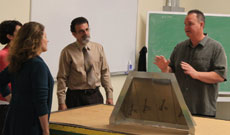Health Care Reform for Workers and Working Families
Click here to view the full report.
Introduction by Chairman, Michael J. Sullivan General President SMWIA & Vice Chairman, Richard H. Bagger Senior Vice President, Pfizer Inc.:
Each day, hundreds of thousands of workers in the United States start their day researching, developing and manufacturing biopharmaceutical products, and building the facilities where those medicines are discovered or produced. The resulting health care innovations are vital to the American people and the nation.The global leader in scientific research, innovation and manufacturing, the U.S. biopharmaceutical industry provides hundreds of thousands of high-paying jobs, and contributes more than $200 billion to the gross domestic product.
The unions and companies of the Pharmaceutical Industry Labor Management Association recognize that a strong domestic biopharmaceutical industry that provides innovative medicines is vital to the American people and to the nation as a whole. At the same time, the association recognizes the need to address issues of mutual interest and concern to the industry, its workers and all Americans, including: accessibility and affordability of health care; funding of innovative research and future cures; and, maintaining a strong biopharmaceutical industry in the United States. As an association of labor and industry, we recognize fully that not only do our employees research, discover and produce the medicines that enhance and sustain lives, they are also patients.
To that end, the trustees of PILMA tasked a working group to study and discuss thoroughly the issues surrounding health care reform so that they could answer this question: How can we, as a nation, make health care reform work for workers and their families?
What follows is a consensus-driven document that embraces our founding principles. We believe by working together, industry and labor can forge common-sense approaches and provide solutions to some of the biggest problems facing workers who are dealing with their health care and that of their loved ones.
As an organization deeply involved in health care, we wanted to do more than just state the problems — we wanted to come together and suggest solutions. We recognize that, despite achieving our goal of reaching consensus among ourselves, not everyone else will agree with our suggestions. And while we know that our solutions don’t address all of the challenges facing the American health care system, this document represents our best efforts to address key reform issues and join a dialogue about solutions.
With an economy facing challenges of historic proportions, we understand we must work even harder to find real solutions. We believe fully that significant reform of the health care system today is a requirement of economic recovery, not something we can afford to put off until another day. Today’s economic crisis compels us to come together now and help forge health care solutions that expand coverage, improve quality and provide value. By acting now, we can make meaningful change that will benefit America’s workers and their families at the time when they need help most.
We welcome the opportunity to participate in this important dialogue.
Chairman, Michael J. Sullivan
General President Sheet Metal Workers’ International Association
Vice Chairman, Richard H. Bagger
Senior Vice President, Pfizer Inc.


